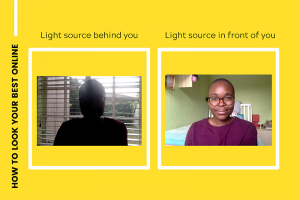A lot has been written about the pros and cons of remote work. The web is awash with pontification on when, if, and how work life will return to a version approximating pre-covid times, but all this discussion is based on our current experience of virtual work. We’re in the early days of adapting to this model and we think there’s a lot that can be done to improve it. Changing the baseline will have important implications for long term decision making.
Boom
Massive upheavals have been crashing into the status quo since the dawn of time (just ask the dinosaurs). Seismic change like this is uncomfortable (just ask the dinosaurs) but taking a step back, responses to situations like these are always the same; the dazed confusion of the immediate aftershock, the anger/denial/depression after counting the losses, then the world moves on, led by those who adapt best to the new conditions.
When the coronavirus barrelled into 2020, it forced the adoption of something that’s been hovering in the wings for some time; remote work. Some have taken to this with relish, immediately selling the desks and canceling office rental agreements, while others can’t wait to go ‘back’ to the old way of working. Even behemoths like BP have got in on the action. Among our clients we’re hearing a lot of discussion around whether (or when) to go back to the office, or what a hybrid model could look like, but less attention being given to fully exploring the possibilities of where we are now. Remote work is obviously a better fit for some organisations, functions and people than others, but organisations cannot afford to be too insular in their thinking. When Apple’s Tim Cook gives virtual work his stamp of approval, it’s a safe bet to assume that’s going to have an impact on how the tech industry functions. Organisations that are too rigid may find top talent looking elsewhere.
If industry-level change doesn’t provide sufficient motivation, there’re plenty of factors closer to home that warrant an exploration of what’s possible with this model. The benefits are significant and those that fail to exploit them are at risk of finding themselves on the side of the dinosaurs.
The upside
For starters, we need to consider the joys of the remote working model. As someone who commuted across the country almost weekly for nearly 10 years in my role at South Africa’s National Treasury, I can testify to the extraordinary cost of commuting (in time, money and energy, not to mention environmental impact). Certainly some of those meetings needed face to face interaction but what percentage – 70%, 50%… 30%?
Cutting these costs are the obvious savings, along with reducing overheads by downsizing the office, and then there’s the tantalising prospect (for those with a home office) of having an undisturbed, quiet space for thinking work that many craved in an office environment (if the communal office favoured the extroverts, then introverts – this is your time!). Organisations have an opportunity to use the savings in interesting and creative ways to compensate for the lack of constant contact, for example:
how would your team choose to spend time together if the sole purpose was to connect?
When physical proximity is not a requirement it opens up the recruitment pool, as well as access to new markets. My coaching practice (along with every other coaching practice, globally) was pulled into an online model, almost overnight. Removal of geographic barriers means that we can now serve international markets from a relatively cost competitive location – a big advantage for large scale coaching programmes.
At first glance, working online creates distance between people. However, for large, dispersed institutions that have significant cost and logistical barriers to assembling physically, the introduction of virtual gatherings actually lowers the barriers to connecting. We recently ran a 5 day, 120 person strategic planning session – online – for a public sector client. It required a four person facilitation team, very detailed planning, and several creative diversions from the script, but after the session the client reported that the experience had opened their eyes to what was possible with this format. This is an institution that previously could only afford to bring people together once a year – we’re currently working with them to triple the frequency of these sessions.
Another client – a highly creative design agency – was convinced that a virtual model wouldn’t work for them. But after several online sessions where we focused their creativity inwards, on their own process, they devised a way to use an online collaboration tool which maintained the quality of their work while reducing development time, through standardised processes and asynchronous feedback.
Going beyond the institutional-level benefits, the environmental impact of fewer planes, trains and automobiles has been well documented. Exhibit A:

Mount Everest. Visible from Kathmandu for the first time in living memory (Photo: Abhushan Gautam)
It’s not all upside
So with all that goodness, why the sinking feeling when we receive an invite for yet another 2 hour team Zoom call? A lot of reasons; meeting overload, lack of imagination, trying to use old tools in a new paradigm, unstable internet connections, and on it goes. I’ve been looking into the issue of how individuals engage with technology, partly because it’s the simplest to fix but mostly because it’s so damn distracting when it’s bad. In answer to the question above, one of the main reasons online meetings can be so tedious is that we get energy from connecting with people, and for many out there, your beautiful, engaging, 3D self is being squeezed into a distorted, 2D, stutter-fest that’s doing a terrible job of approximating the real thing.
The experience is draining because the technology gets in the way of connecting with each other, much like trying to have a conversation with someone through a closed, dirty window. Windows are for seeing through, not looking at, and like that grubby window, the technology gets our attention when it’s not working: frozen frames, audio dropouts, microphone scratching on a jersey, the person showing up sideways in portrait orientation, stubbornly refusing to right themselves. These distractions absorb energy, meaning extra effort is needed to focus on the content, leading, inevitably, to a feeling of exhaustion (and relief) when we finally get to hit the leave meeting button.
By way of illustration:

(Yes, this is an actual screen grab from a real meeting)
We’re told that 80% of communication is non-verbal. In that case, we have to question how much of this individual’s point is coming across. Let’s hazard a guess at not much. They may have something fascinating to say about new market opportunities in Australia but their appearance is so distracting that we aren’t listening. Note: this is worse than a phone call – it’s actively pulling attention away from the substantive issues. The good news is that with a bit of attention to detail, you can take a quantum leap forward with how you present online.
Unlike meeting someone in person, in a videoconference we only have 2 senses to go by: audio and visual, so it’s important to pay attention to both. Starting with the visuals:
Assuming the camera is on (it should be) you need to actually be visible. This means attending to framing and light.
LIGHT: Positioning yourself between the camera and bright light source (like a window) is great if you’re Bansky and want to remain anonymous – it’s terrible if you want to build connection with the people you’re working with. At the risk of stating the obvious: you need light on your face. That said, if you wear glasses and have a bright light directly in front of you, it’s going to reflect in the lenses. Biologically, when we can’t see someone’s eyes we trust them less. (This short clip will be helpful for the bespectacled reader.)

My colleague Bonolo, perfectly illustrating the do’s and don’ts of positioning relative to your light source
FRAMING: You have a 16:9 frame to work with in Zoom – how do you want to use it? An extraordinary number of people we’ve worked with recently seem heartily convinced of our interest in their ceilings. Leaving your laptop on the table and peering down at the screen is the equivalent of a tall person standing too close to a short person; you’re literally looking down at them. It’s imposing and doesn’t help conversational flow and it’s impolite to subject your team to a view up your nasal passages. Your camera should be at eye level, which may mean stacking your laptop on a pile of books to get started. You’ll need an external keyboard and mouse – a small investment for which your colleagues, and your spine, will be grateful.
The built in webcams on most laptops are at best basic, especially true for those with older machines. An investment in a decent webcam like this will make a substantial difference in image quality (remember, we’re looking to represent you as closely as possible). The same is true of audio. Most laptop microphones produce a tinny, hollow squawk that creates the impression you’re on Mars – no place to be conducting a team meeting from. In a digital sense, audio represents half of you, so it matters. External USB microphones (even budget versions like this) make a dramatic difference to how you sound and decent unidirectional mics do a good job of isolating your voice from background noise.
Many people like to wear earphones during a call. That’s fine when it’s for privacy or to block out the sound of the neighbours barking dog, but when we’re talking to a colleague with earphones on there’s a natural instinct to wonder if they’re listening to music. In a face-to-face scenario, we’d never have a conversation with someone ensconced between the giant cups of DJ ‘phones. If I’m not sure that I have your full attention, I automatically limit mine – cue the checking of mail and WhatsApp during a meeting (surely the definitive sign that things aren’t working). Some may deny that they respond to these signals in this way, but our reactions in these situations are subconscious and instinctive.
The pattern that is hopefully emerging is of the need to mimic real life when working virtually. You wouldn’t sit under the table in a meeting room, so don’t turn the camera off. You wouldn’t put a mirror in the chair opposite you, so hide your self view and hold off on the pruning. You wouldn’t have a conversation with a colleague positioned so they have to stare into the sun, so don’t position your camera so your newly installed chandelier is directly above your head.
For those who aren’t sure how their digital selves are coming across – ask! Odds are your colleagues are brimming with good suggestions. There are few more satisfying moments than watching a team self-correct when space for feedback is opened and the dynamics are right.
What next?
I’m convinced we’re only scratching the tip of the iceberg of what’s possible with remote work. Does it mean all companies should give up their office and we never get to share a cuppa with our colleagues again? Of course not. The need for human interaction is what makes us… you know… human. In-person meetings will always provide something a virtual interaction cannot and those valuable informal interactions are very difficult to orchestrate online, but if organisations can a) get really good at working remotely, and b) get really good at identifying the situations that can be virtual from those which need face-to-face interaction, then there’s an opportunity to leverage the upside and limit the downside of both models, which surely translates into competitive advantage in most industries.
Many of these points are fairly obvious and easily remedied and of course no one shows up badly on purpose. For many out there (I’m looking at you, Boomer) this is new and we’re still figuring it out. Everyone knows how to dress for the office, yet how we show up online at the moment is the equivalent of walking into the boardroom in shorts and a tomato-sauce stained t-shirt.
For most of our clients, the pressure is on and leaders and teams are scrambling to figure out how best to respond to the changes. Energy is in short supply, which is exactly why this is important; a little more mindful, a few simple changes, and these interactions may be at the very least less draining, and at best energising, productive, connecting experiences.
Will a webcam and an external mic magically transform our work lives and consign city centres to ghost towns? Obviously not. But if individuals improve how they show up, if leadership becomes more attentive to the nuances of working virtually, and if teams develop the competence to collaborate in genuinely interesting, energising, creative ways online, there is a real chance of remote work and all its benefits, becoming an integral part of our professional lives in the future. Then we can all go to Kathmandu to get a peek at Everest.
This is the first in a series of three articles. In the next, I’ll discuss some of the things leaders need to be more aware of, and after that, we’ll look at team collaboration. If you’d like to hear more, do get in touch. Michael is a writer, OD consultant and coach. He’s a founding partner at dstlry.com




